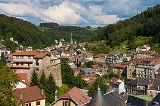
Plombières-les-Bains
Encyclopedia
Plombières-les-Bains is a commune
in the Vosges
department in Lorraine
in northeastern France
.
Les bains refers to the hot spring
s in the area, whose properties were first discovered by the Romans
. In succeeding centuries, its baths were visited by Montaigne, Voltaire
, the Dukes of Guise, the Dukes of Lorraine, Beaumarchais
, Napoleon Bonaparte, Joséphine de Beauharnais
, Napoléon III, Berlioz, Lamartine and Alfred de Musset
.
and the Camillo Benso, conte di Cavour, who secretly negotiated the “Treaty of Plombières.” This accord granted French aid to the cause of Piedmont-Sardinia
against the Austrian Empire
in return for the territories of Savoy
and Nice
, which thereafter became French territory.

Communes of France
The commune is the lowest level of administrative division in the French Republic. French communes are roughly equivalent to incorporated municipalities or villages in the United States or Gemeinden in Germany...
in the Vosges
Vosges
Vosges is a French department, named after the local mountain range. It contains the hometown of Joan of Arc, Domrémy.-History:The Vosges department is one of the original 83 departments of France, created on February 9, 1790 during the French Revolution. It was made of territories that had been...
department in Lorraine
Lorraine (région)
Lorraine is one of the 27 régions of France. The administrative region has two cities of equal importance, Metz and Nancy. Metz is considered to be the official capital since that is where the regional parliament is situated...
in northeastern France
France
The French Republic , The French Republic , The French Republic , (commonly known as France , is a unitary semi-presidential republic in Western Europe with several overseas territories and islands located on other continents and in the Indian, Pacific, and Atlantic oceans. Metropolitan France...
.
Les bains refers to the hot spring
Hot spring
A hot spring is a spring that is produced by the emergence of geothermally heated groundwater from the Earth's crust. There are geothermal hot springs in many locations all over the crust of the earth.-Definitions:...
s in the area, whose properties were first discovered by the Romans
Ancient Rome
Ancient Rome was a thriving civilization that grew on the Italian Peninsula as early as the 8th century BC. Located along the Mediterranean Sea and centered on the city of Rome, it expanded to one of the largest empires in the ancient world....
. In succeeding centuries, its baths were visited by Montaigne, Voltaire
Voltaire
François-Marie Arouet , better known by the pen name Voltaire , was a French Enlightenment writer, historian and philosopher famous for his wit and for his advocacy of civil liberties, including freedom of religion, free trade and separation of church and state...
, the Dukes of Guise, the Dukes of Lorraine, Beaumarchais
Pierre Beaumarchais
Pierre-Augustin Caron de Beaumarchais was a French playwright, watchmaker, inventor, musician, diplomat, fugitive, spy, publisher, arms dealer, satirist, financier, and revolutionary ....
, Napoleon Bonaparte, Joséphine de Beauharnais
Joséphine de Beauharnais
Joséphine de Beauharnais was the first wife of Napoléon Bonaparte, and thus the first Empress of the French. Her first husband Alexandre de Beauharnais had been guillotined during the Reign of Terror, and she had been imprisoned in the Carmes prison until her release five days after Alexandre's...
, Napoléon III, Berlioz, Lamartine and Alfred de Musset
Alfred de Musset
Alfred Louis Charles de Musset-Pathay was a French dramatist, poet, and novelist.Along with his poetry, he is known for writing La Confession d'un enfant du siècle from 1836.-Biography:Musset was born on 11 December 1810 in Paris...
.
Treaty of Plombières
The "Pavilion of the Princes" at Plombières, known in less interesting times as the administrative offices of the thermal station, achieved retrospective fame as the meeting place on 12 July 1858 between Napoleon IIINapoleon III of France
Louis-Napoléon Bonaparte was the President of the French Second Republic and as Napoleon III, the ruler of the Second French Empire. He was the nephew and heir of Napoleon I, christened as Charles Louis Napoléon Bonaparte...
and the Camillo Benso, conte di Cavour, who secretly negotiated the “Treaty of Plombières.” This accord granted French aid to the cause of Piedmont-Sardinia
Piedmont-Sardinia
Kingdom of Sardinia or Sardinia, also Piedmont-Sardinia, Sardinia-Piedmont or Piemonte, refers to the states of the House of Savoy from 1720 or 1723 onwards, following the award of the crown of Sardinia to King Victor Amadeus II of Savoy under the Treaty of The Hague...
against the Austrian Empire
Austrian Empire
The Austrian Empire was a modern era successor empire, which was centered on what is today's Austria and which officially lasted from 1804 to 1867. It was followed by the Empire of Austria-Hungary, whose proclamation was a diplomatic move that elevated Hungary's status within the Austrian Empire...
in return for the territories of Savoy
Savoy
Savoy is a region of France. It comprises roughly the territory of the Western Alps situated between Lake Geneva in the north and Monaco and the Mediterranean coast in the south....
and Nice
Nice
Nice is the fifth most populous city in France, after Paris, Marseille, Lyon and Toulouse, with a population of 348,721 within its administrative limits on a land area of . The urban area of Nice extends beyond the administrative city limits with a population of more than 955,000 on an area of...
, which thereafter became French territory.
External links
Office du tourisme des Vosges méridionales Official site http://avancee.free.fr/ Association "Le Marché de Noël" Compagnie Thermale de Plombières-les-Bains Plombières-les-Bains sur le site de l'Institut géographique national Plombières-les-Bains sur le site du Quid Localisation de Plombières-les-Bains sur une carte de France et communes limitrophes Plan de Plombières-les-Bains sur Mapquest

